

- Call 908 543 4390
- Email
- Dr.Joni Redlich PT,DPT



We know it is only the beginning of October, but EVERYONE is already thinking about Halloween (we know you are)! There are so many fun, spooky, but also wholesome fall themes all around, like pumpkin EVERYTHING, little ghosts, the monster mash, and so so much more. Because this whole month seems to be filled with Halloween goodness, we wanted to bring you our Halloween themed exercises early, so you can practice them ALL MONTH LONG, all the way to October 31st! So let’s get Monster mashing, come on!
The Frankenstein Kick 
Stand with your arms out straight in front of you, and walk forward while kicking your legs straight TEN times. Kick your hands if you can! Now you are doing the Frankenstein Kick!
The Zombie Drag 
Lie on your tummy on the floor. Now drag yourself forward (aka do an army crawl) switching your arms 10 times! You can make this even harder if you pretend you are a Zombie who’s legs went missing and try to just move using your arms (it is so tricky).
The Pumpkin Roll 
Sit on your pelvis, criss cross applesauce. Now hug your knees close to your chest with both arms. Roll toward one knee, forward, and then try to sit back up. If you keep going in the same direction, you will start moving in a circle, so try it 5 times to the right then 5 times to the left. If you can’t do this one it is okay it is very hard. An alternative position is the stable pumpkin: Hug your knees into your chest and hold for 10 seconds!
The Mummy Twirl 
Pretend someone is wrapping you up in a whole roll of toilet paper (or actually use the toilet paper for this one and make it even more fun). Hold your imaginary or real toilet paper in between your arm and your side. Then twirl 10 times to the right to wrap yourself up tight like a mummy. Untwirl yourself by going 10 times to the left so you are not so dizzy (and not left mummified)!
The Flying Ghost 
Okay, we are going for the scare factor on this one, kids. Jump as high as you can into the air, bring your arms up over your head, and say BOO! Repeat this 10 times in a row to be the SCARIEST ghost on the block!
And there you have it, ghouls! Have fun performing these exercises to let your inner monster out and to get in the Halloween spirit! Stay tuned this month for more Halloween themed fun and tips to last you the whole month of October. Have fun moving and grooving, and remember to keep it SPOOKY!

The school year has kicked off and is already off to a great start! Attending school is such a privilege because our kids are allowed to learn new things from both teachers and peers. One important topic for children to learn about in school and at home is neurodiversity. Neurodiversity is a concept which is inclusive toward conditions like Autism, ADHD, Dyslexia, Sensory Processing Disorder, and other diagnoses. The topic of neurodiversity advocates against stigmatization of those who are neurodiverse and helps to prevent the idealization of the brain and body developing in one specific way. Children need to know that the brain and body can develop in many beautiful and different ways, and that not everyone sees and experiences the world in the same way.
Through education, children can learn to acknowledge, understand, and respect the differences in themselves and their peers. Many children face different sensory and motor challenges and every child has their own sensory motor strengths, and this is an essential part of life! Teaching kids about neurodiversity promotes understanding and helps to prevent the othering of neurodiverse populations. It also helps kids acknowledge and advocate for themselves or others if access to resources is difficult. It helps them understand that just because someone acts a little differently, moves a little differently, or talks a little differently than they do, that is okay and that they should be celebrated for who they are!
One GREAT way to help teach your child about neurodiversity at home is to provide access to books that talk about it in a way that makes them think about and understand the topic. So, without further ado, here are six children’s books that discuss various topics under the umbrella of neurodiversity so you and your child can learn and grow together:
This book utilizes 26 alphabet lessons to nurture social and emotional intelligence among children. It teaches them how to better humanity and work towards a better and brighter future. There are many different topics which are about respecting others, celebrating others, and learning about how to be the best person one can be!
This book is about the true story of Jennifer Keelan-Chaffins and her participation in the Capitol Crawl. This book discusses Jennifer’s drive to question America about why public spaces were not accessible to individuals with disabilities. It details HOW her activism helped lead to the formation and passing of the Americans with Disabilities Act (ADA), which has gone on to benefit SO many Americans to this day (although more spaces and events need to continue to improve their accessibility).
This book is written about Dr. Temple Grandin. Temple was diagnosed with autism at a young age, and faced many challenges growing because many had expectations of her that were not true! No one expected her to talk, let alone become one of the most powerful voices in modern science. Using her powerful and unique mind, she started connecting with animals in a special way. Through this connection and her own perseverance, she became an amazing scientist and inventor, creating revolutionary improvements for farms around the globe!
This is a social-emotional comic book that helps children learn to identify and regulate their behavior in response to outside stimuli. Many kids have trouble controlling how they feel inside in response to things going on around them and need a little support emotionally regulating! This is a great book to teach kids how to be aware of this in themselves and others, how to describe their feelings when they begin to feel overwhelmed, and also for educators interested to understand and support the neurodiverse children in their classroom.
This book helps to celebrate neurodiversity. It begins with the idea that neurodiversity is a normal, essential part of human biodiversity. Without Neurodiversity, we wouldn’t have great minds like Picasso, Einstein, or Greta Thunberg! This book encourages everyone to focus on our strengths and to understand that each brain is unique, which is wonderful!
This book follows a group of children as they each build their own hot-air balloons. It features the kids working together and using their own strengths to create beautiful things. It showcases the fact that we are all different and that the world is a better place when we use our differences and our unique skills to create bright, exciting things as a team!

As we are finally back to school, it is important to also acknowledge and address the stress that may accompany a return to the school environment. Any transition to a new setting can be stressful, especially for children with disabilities. The combination of an unfamiliar environment, interactions with peers, classroom expectations, unpredictability, reduced control, change of routine, challenging coursework, facing the unknown, or the impact of disabilities can signal the stress system (aka sympathetic nervous system) in our children’s bodies. This is also known as the fight, flight or freeze system. When faced with fear, uncertainty, a perceived threat, or the anticipation of a stressor our bodies will increase the stress messengers of the body (aka adrenaline and cortisol). This results in changes in breathing, heart rate, blood pressure, posture, concentration, and also systems like digestion. As this is a normal response in the human body, sometimes it can be overactive and can impact a child’s ability to engage with peers and learning activities.
As parents/ educators/ therapists, our desire is that our kids thrive and enjoy learning about our crazy, cool world with confidence and curiosity. A calm, confident, and aroused state is key to this success in the classroom and with peers. Luckily, our body always tries to have a balance (homeostasis) by having its own checks and balance system.
Introducing: the de-stress system (aka parasympathetic nervous system) which counteracts the stress messengers and helps achieve a calm state. Successful strategies of managing stress often include techniques that help stimulate this de-stress system. Such strategies include slow/ controlled breathing, postural alignment, reducing arousing stimulus, adjusting exposure to stressors, calming touch, engagement in a soothing activity, spending time in nature, and consistent exercise.
Below are some practical tips to incorporate these de-stressing strategies into your household routine for your children and the whole family!
Recommendations:
This post is for education purposes only. Please seek medical advice from a licensed health care provider that directly manages your care.
Further reading on stress:
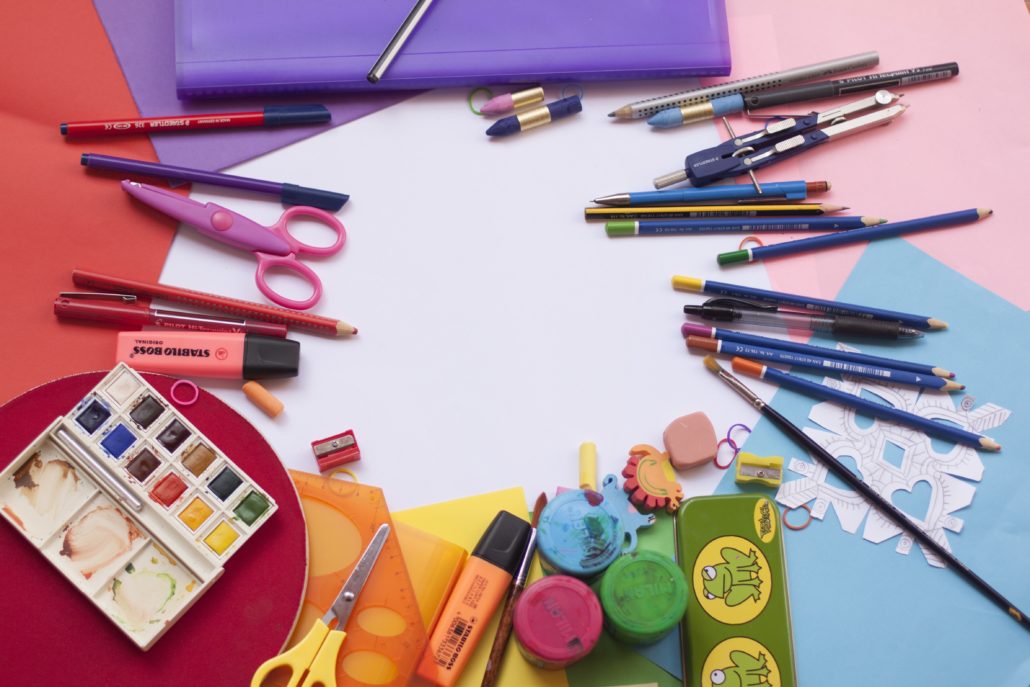
…and what to do if this is a challenge!
Do you know what is more fun than learning new school concepts while sitting at a desk…?
Learning while on the MOVE!
Sometimes combining movement with learning helps kids learn faster if they function better while on the go.
This is especially so if your kiddo is a mover and a shaker and loves being active and on the go. Using movement, a strength of theirs, to teach something new may open up the neurological floodgates in new ways. This can give your child access to different and novel pathways in the brain to reinforce concepts as opposed to taking the same traditional and traveled routes!
Learning with movement is also a change from the norm, and even if your kiddo doesn’t always crave movement, any new way of learning is usually more engaging than the same ol’, same ol’! The brain loves novelty, so let’s take advantage of that to build some new connections!
So let’s stand UP and try these fun learning games with us:
Do these kinds of exercises seem tricky for your child?
All of these exercises practice something called “dual tasking” where your child is required to perform a task with their body (a motor task) and their mind (a cognitive task). These kinds of tasks are great to practice with your child because with practice, they make it easier for the body and the mind to work on things at the same time. These kinds of tasks can be very difficult for some kids, especially if their body is taking a lot of their attention away from the cognitive tasks they are being asked to do (like schoolwork).
When does this happen? This happens when balancing and controlling their body is very hard and the child is diverting focus to keeping their body still and in one place. If you feel like your child is spending a lot of energy and focus just keeping their body still and in one place, they may benefit from physical therapy to improve their balance and overall control of their body. Giving a child this kind of control can improve their lives for the better because their brains are free to think, focus, and remember things from school and beyond!
Here are a few red flags that dual tasking is tricky for your child:
If this sounds like your child, call us at 908-543-4390 to set up a free Discovery Visit with one of our Physical Therapists to see if Physical Therapy would benefit your child!

WHY “Good Posture” is So Important for School!
by Dr. Ali
We are always hearing about “good posture” and how important it is for us. We hear “sit up straight” and “don’t slouch” often, whether you are saying it to your kiddo or you hear another parent or a teacher saying it to another kiddo. What is never partnered with these phrases is WHY this is so important. I wish that as a kid, somebody told me why sitting up tall was so important, because if they had, maybe I would have done it more instead of slouching!
Sitting with supported, aligned posture is SO important for every body, and for all mobility statuses. If you are curious as to WHAT good posture looks like, click HERE to read a blog post all about appropriate postural alignment and for some solutions to help with sitting posture throughout the school or work day.
It’s also important to remember that a “good posture” is also one that you’re not in for too long! We want to empower our kids to listen to and respond to what their bodies need- that may be using a standing desk for periods of the day or sitting on a wedge to support a more traditional aligned upright posture. However, we do want all of our kids to have the flexibility and postural control to sustain an actively aligned posture for periods of time.
SO, without further ado, we are here to tell you all about one of the BIGGEST benefits of sitting with nice, spinal alignment. And what is this benefit you ask? BREATHING! Sitting with your spine in a properly aligned position makes sure that your ribs are in the right places to allow for proper expansion when we breathe in. Sitting with our core activated, with our ribs and spine in a proper alignment ensures that your diaphragm (the big muscle that attaches to your ribs and sits below your lungs) is in the perfect position to contract and relax for breathing. With your ribs and spine in the right position, your lungs have enough room to expand and let in all the air they can. Then your breathing muscles (the diaphragm and more) are in the best position to bring in all that air (aka a win win)! When you sit up TALL, your breathing is not SMALL!
So, WHY is breathing efficiently important for effective learning throughout the school day? Breathing in big, natural breaths gets oxygen into our lungs, which then gets taken all over the body. Our brain needs oxygen to think all the thoughts we need for our school lessons. The heart needs oxygen to keep beating with a strong and healthy rhythm. The arms and legs need oxygen to fuel their muscles to move and groove or patiently raise a hand to answer a question. The stomach and intestines need oxygen from the blood to digest your yummy lunch so you can turn it into energy! Basically, the WHOLE body needs oxygen to keep on keeping on and to continue doing what each part is supposed to do!
The body needs oxygen for SO many things! And not just any amount of oxygen, but the right amount of oxygen. If the lungs fill with too little oxygen, then the body is only working off of what it has, and maybe compensating for the energy it is missing. You may feel tired throughout the day, with lots of yawns and trouble focusing. This is something we definitely want to avoid when our kiddos go back to school! When they go to school for the day, we give them a hearty breakfast in the morning to make sure they have enough energy to last them until lunch time and a hearty lunch to get them through the rest of the day. BUT both of these amazing meals are not going to help them combat the tiredness they will feel if they are not breathing right all day long at school because of poor posture.
Good posture and optimal breathing supports emotional regulation, by increasing access to the parasympathetic nervous system, the opposite of our “fight or flight system.” It impacts a child’s ability to use their eyes, especially for desktop work, but also the ability to move back and forth between looking far at the teacher and looking close at desk work. It also impacts handwriting and other fine motor skills.
Our ability to sustain our posture over a long period of time is not only the result of the chair we are sitting on but also our body’s ability to sustain “good posture” using our muscles and sensory system. Some kids have a hard time with the muscular endurance or strength required for good posture. Others have a hard time sensing where their body is when sitting and thus sit in a very relaxed, forward curved posture. Some kids have a combination of both of these factors (and typically this is the case). If you notice your child sitting with slouched posture at home, you can probably assume they are sitting that way at school. If they are sitting that way at school too, they are not breathing in the most efficient way and may not be getting the proper amount of oxygen throughout the day for peak concentration! If you feel like this is your child, it is not something that can’t be helped and improved with physical therapy! Through physical therapy, your child can learn to support their body with supported posture and build the muscle strength and endurance to hold that posture for much longer stretches of time. If you feel like your child spends a large part of the day slouching when they sit, do not hesitate to call us at KidPT to schedule a free Discovery Visit so that we can screen your child to see if PT is appropriate for them, and if we are a good fit, to help them learn to sit with ease!
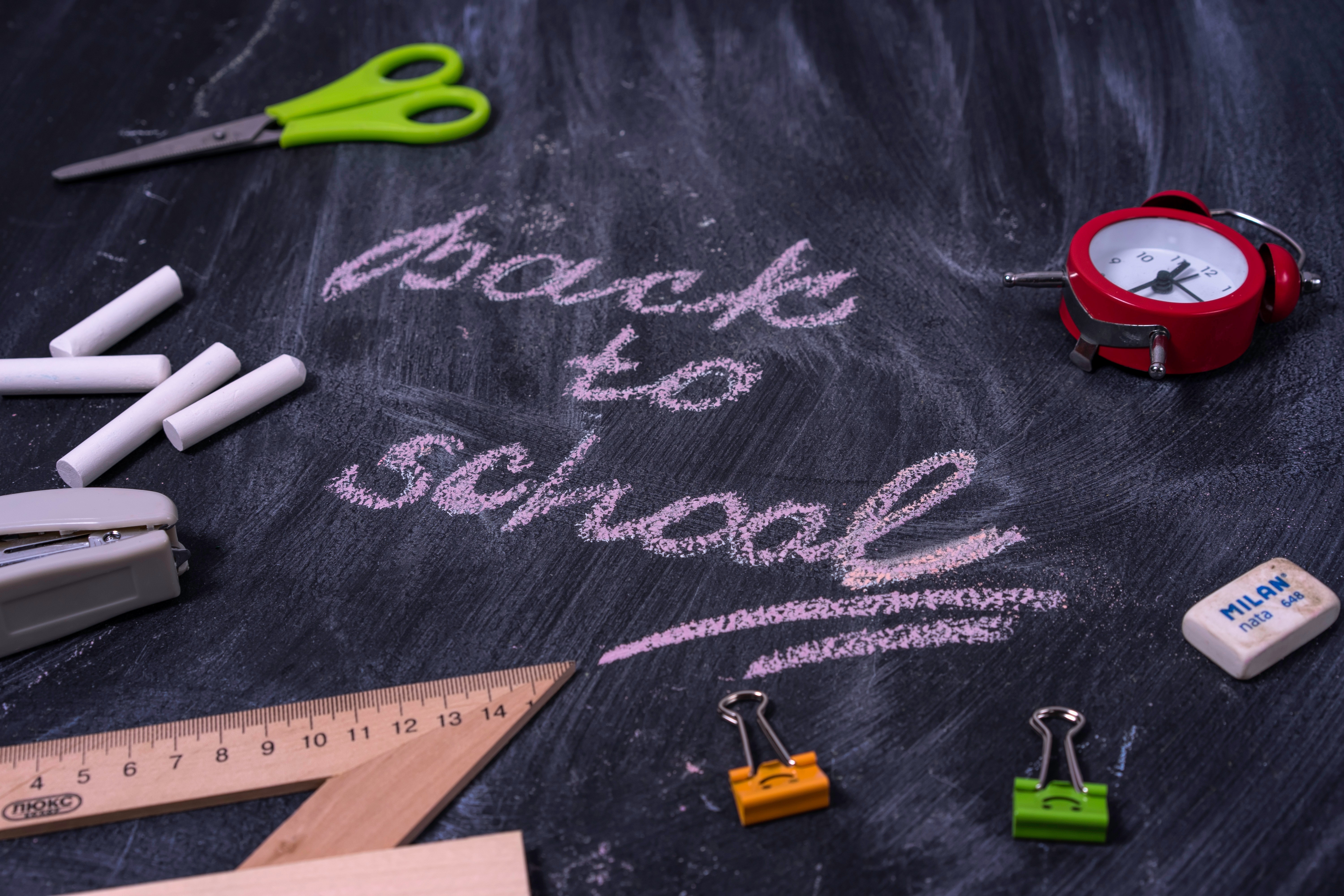 It is almost back to school time! You must have a lot of things on your plate between enjoying the last few glory days of the summer and also preparing for the start of a new school year. So we have made it easy for you with a quick guide of things to consider when purchasing a backpack.
It is almost back to school time! You must have a lot of things on your plate between enjoying the last few glory days of the summer and also preparing for the start of a new school year. So we have made it easy for you with a quick guide of things to consider when purchasing a backpack.
Although the stores are stocked with bookbags with cool colors, designs, and beloved cartoon characters, try to avoid only considering the style and appearance when purchasing a bag for your little ones. Research has shown that heavy and inappropriately fitting backpacks can alter posture and alignment and place stress on the musculoskeletal system leading to neck, shoulder, and back pain or injuries with repeated use. Our bodies are complex and dynamic with many systems working together. When one area or system is stressed or overloaded, the body adapts with compensations in other areas. Unfortunately, repeated use of poorly fitting or heavy backpacks can lead to inappropriate postural alignment compensations and stress down the structural chain of the body. Since bookbags are used by our kiddos for a significant time throughout the school year, it is important to take steps to ensure appropriate use to avoid injury or compensations.
A few key concepts to follow when choosing a book bag are to increase the amount of contact area between the child and bag, minimize and distribute the weight, ensure symmetry, and keep the load as close to the trunk as possible. Below are characteristics to look for and practical tips to assist you on this back to school endeavor.
Optimal backpack characteristics:
Optimal backpack use and tips:
Signs of poor fit and use:
Please do not replace medical advice from your primary care physician, orthopedist, or physical/ occupational therapist with the information presented in this blog post. Always consult your medical team with medical advice.
https://www.choosept.com/resources/detail/backpack-safety
https://cdn.ymaws.com/www.ccapta.org/resource/resmgr/imported/MCBackpackSafety.pdf
by Dr. Ali
This week we are going to get BUGGY! There are two different types of people out there, those who think bugs are really cool and helpful and those who think bugs are the scariest beings to walk on earth. Although bugs may not be some people’s favorite things, there are so many out in the summer, doing their little buggy jobs here and there. They are all so different from each other in shape, color, and especially in HOW THEY MOVE! Because of this, we thought it would be fun to bring you and your kiddos BUGGY MOVES this week!
The Butterfly Flap: 
The Super Ant Pick Up:
The Jumping Spider: 
The Scooting Worm:
We hope you enjoy these summer bug-tastic exercises! We know you are “bugging” out that summer is almost over (so are we) but we are trying to enjoy every last bit. Happy summer everybody (and every buggy), have fun squirming, jumping, and flying like our little friends do!

It is SUMMERTIME and with summer comes many fun outdoor activities.
One of these is Swimming!
Swimming is great for any kiddos who have low tone, neuromuscular conditions that affect movement strength or control, and for conditions that affect one’s joints. For any child who falls in one of the diagnostic categories listed above, moving in the water helps because buoyancy (aka what helps you float a little bit when you swim) takes away some of the gravity that typically weighs us down when we move! Though we love gravity to help keep our feet grounded when we move around on the earth, it does make it more difficult for kiddos who have low tone or neuromuscular related weakness to perform tasks that require them to move against gravity or require their muscles to have to sustain endurance against the forces of gravity throughout the day. For children who have a condition that affects their joints, the buoyancy of the water relieves a portion of the downward pressure exerted on their joints with every step on land.
Now, while buoyancy makes time in the water a little easier than time on land, we can’t forget about the other properties that make exercises in the water a true workout. Water is more viscous than air, meaning it is thicker and harder to move through. Not only is water thicker than air BUT water molecules love to stick together too, a property called cohesion. When the molecules stick together, again it makes them harder to move through than air, because as we are moving through water, we are resisting the force required to maintain the bonds between water molecules. I’ll bet you never thought you were breaking bonds every time that you go for a swim, but it’s neat right?!
That said, here are some activities that your kiddo can do in the shallow end of the pool (with supervision of course) that will help strengthen them for their time as a landlubber (aka when they are on land again):
Want to learn about more fun exercises for Summer? Visit our instagram @KidPT or check out more of our blog posts!
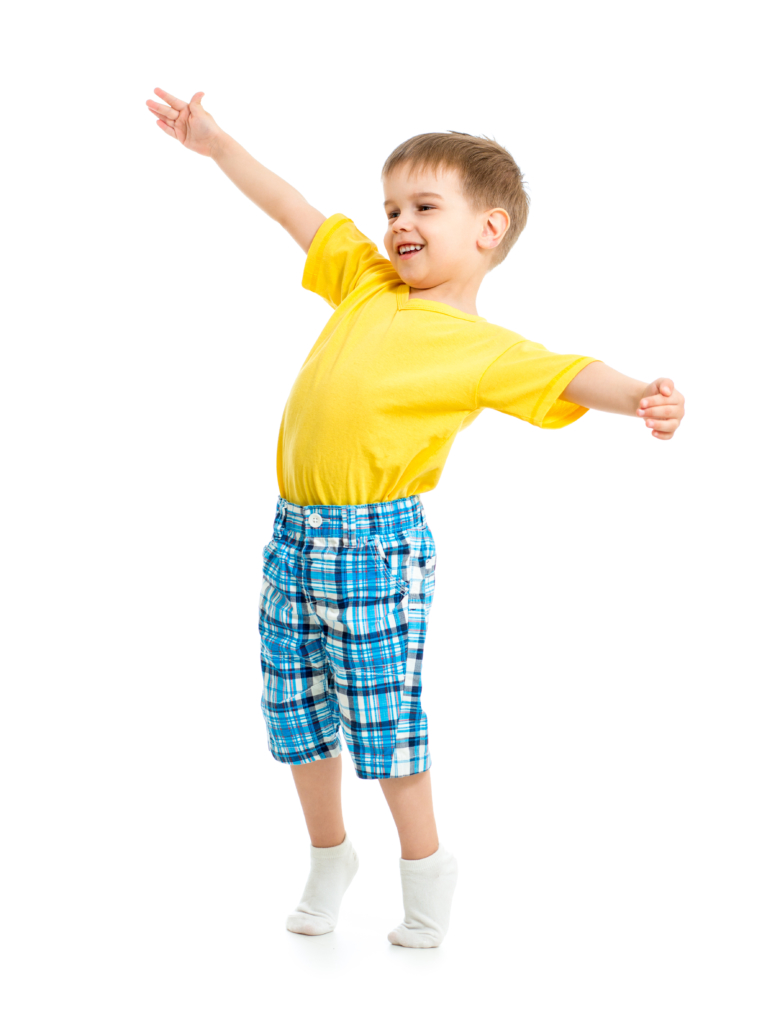
by Dr. Ali
Toe walking is something that is frustrating for many parents and their kids and our parents are often worried about their child’s balance or overall joint health of their feet and ankles as they age. The children are frustrated with always being told to walk on flat feet when they feel like they really can’t control how they are walking! We often hear “They’ll walk on flat feet when they’re thinking about it, but as soon as they stop thinking about how they are walking, they are back up on their toes again!” We hear this over and over again from parents. If you have been to another physical therapist for your child’s toe walking, often they just stretch, stretch, stretch them… your child is miserable and in pain AND there is often no change in their toe walking.
We look at toe walking a little differently. The body is a movement system if the system is not moving the way it is designed to, there must be a reason! The important question we therapists always ask is WHY! When a child walks on their toes, they are using a less efficient gait pattern than when a person walks with a heel to toe gait pattern. Our bodies are SMART and they are always trying to optimize their own movement efficiency naturally so that we can move with EASE. Basically all bodies take the path of least resistance, no matter what! That said, if a child is toe walking, it is DEFINITELY meeting an underlying need in their body, or else, they wouldn’t be walking that way. Toe walking IS their body’s path of least resistance. There is something blocking their body from walking with a heel toe gait pattern and making toe walking the easy way to move. THIS is where we pediatric PTs come in! There are many needs that their body might be trying to meet and we are here to help them fill in the little gaps that their body has not been able to do alone (up to this point).
Postural and Biomechanical
Sometimes, the origin of a child’s toe walking is related to their alignment and the way a child uses their core. When this is the primary reason for a child’s toe walking, we will often see the child leaning forward, belly out, with their whole center of mass (aka the middle of their body) positioned forward over their feet. If this is the primary driver of a child’s toe walking, then they need to re-learn how to use their belly muscles and how to re-align and control their whole body while moving before any changes are seen at their feet and ankles.
Sensory
Sometimes toe walking can have a large contribution from the sensory system. Within this realm there could be multiple different sensory needs their toe walking may be meeting. Let’s look at these different needs a little more:
Neuromuscular:
-Sometimes children who present with high tone or low tone can toe walk based on how their system regulates the tone in their muscles. High tone is frequently seen in children with Cerebral Palsy or children who have had a Traumatic Brain Injury, and in this sense, when the child moves or tries to walk, the tone in their calf muscles may increase to the point where they are walking up on their toes. In the case of low tone, similar to why children with impaired proprioceptive systems might toe walk, the child might be looking to stabilize joints which are more mobile. By toe walking, children with low tone are increasing their overall joint stability and thus the stability of their body while they move. Neuromuscular contributions to toe walking are more complicated as they require more time, patience, and retraining of the way the child regulates their tone while they move (which is often an automatic process and is only slightly understood by the medical community). The main reason why toe walking can be troublesome for this population, especially in the case of high tone, is that having the foot and ankle positioned in a pointed position while moving and likely while standing or resting too can create something called a contracture. A contracture is the term used when a joint loses movement in a certain direction to the point where it affects the intended function of that joint. When a contracture gets too severe, it might cause skin break down while a child is walking in certain shoes, which could lead to an infection down the line. Contractures are very hard to reverse once they occur and prevention is typically the preferred way to go!
If ANY of these descriptions (or a combination of these) sound like your child, they may benefit from physical therapy with the knowledge of how to treat idiopathic toe walking. Gone are the days of “stretching three times a day will make it better” because if you have done this with your child you KNOW that 9/10 time this does not work. At KidPT we treat idiopathic toe walking from the tummy out to the tips of the toes and don’t look over the potentially crucial contributing sensory factors. We will work with you and your child as a team to put the puzzle pieces together (and oh yeah did we mention they will have FUN while doing it). Stop stressing and start getting answers, come in to KidPT today for a Free Discovery Visit and see if WE are the right fit for YOU!
There are many fun activities your child can do on the playground to help facilitate gross motor development, develop coordination skills, and increase overall body strength. Below are just some examples of how to do this to get you started:
Playground Stairs & Ramps: Many playgrounds are equipped with a set of stairs that take kids all the way to the tippy top of a slide. Many of them also have landings that are the perfect height off the ground to allow the kids to jump down (this would be a height of around 16 inches). Practicing this skill lets kids use two feet together to take off and two feet to land at the same time. If they haven’t yet mastered a two footed landing, practicing by jumping down will help with the development of this skill!
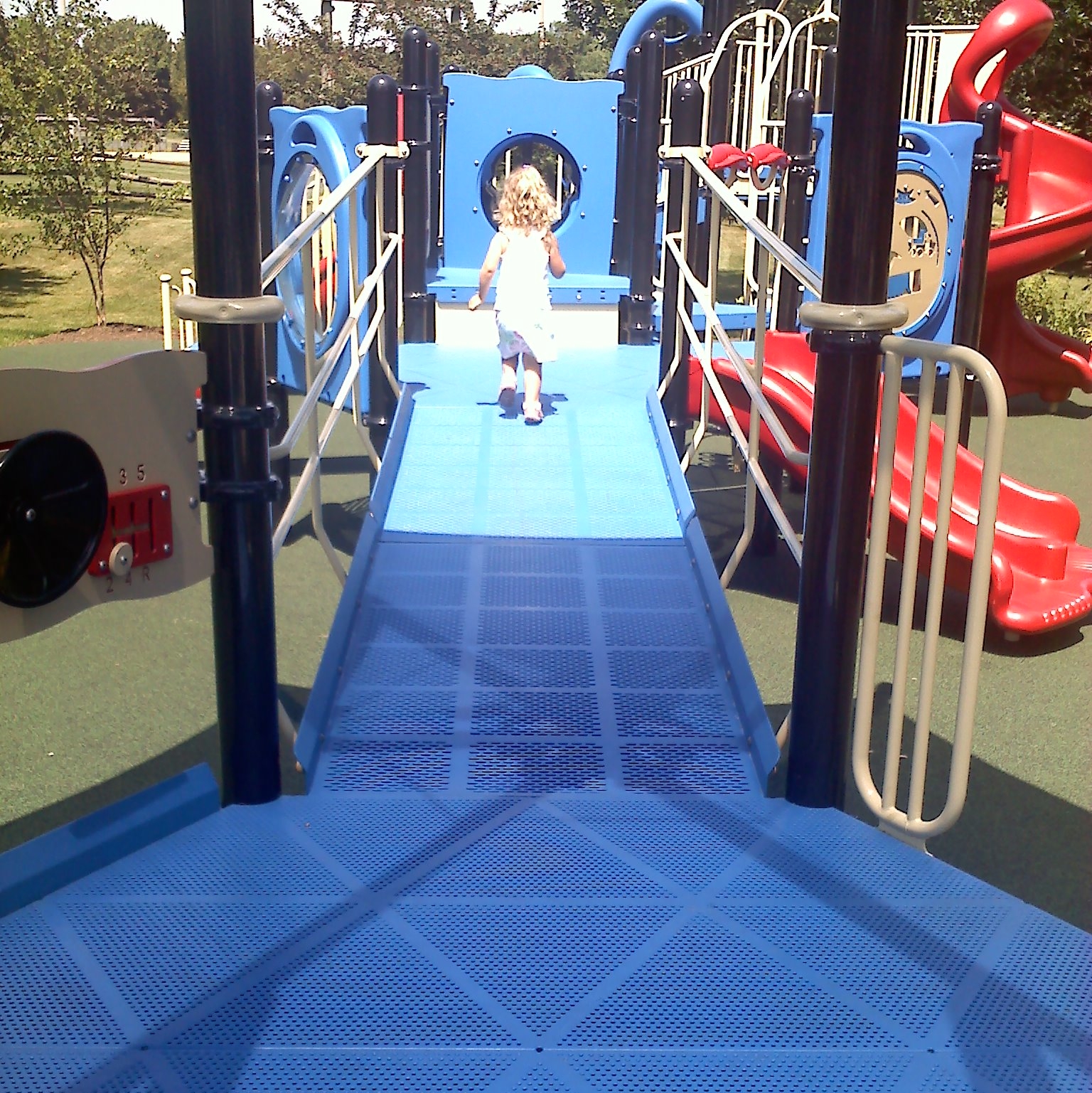
Climbing walls: Many playgrounds have climbing walls these days (which is really cool). Climbing walls are a great way to use and develop a child’s upper body and lower body strength, core strength, and whole body coordination. They have to use their brain to figure out where to place their feet and hands and then coordinate what they have figured out with their bodies to get their bodies to execute each motion. It’s a whole body team work activity!
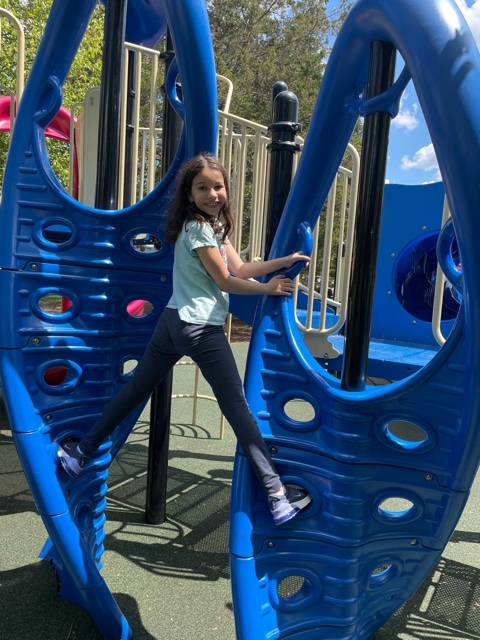
Swings: Swings provide a great foundation to work on postural control and balance using many muscles of the trunk, legs, and arms to do so! The swinging motion requires a child to move their body in opposition to the motion of swing to continue to generate momentum. Each transition of their body between back and front uses a give and take of the front versus the back muscles that help support their spine, hips, shoulders, and etc. Negotiating their body in this way helps teach them how to use these postural muscles and how much to use on each side to create a desired movement. In other words, it teaches them how to coordinate these muscles.

Tubes: Tubes are a great way to build upper body strength and use the core in a way we typically don’t once we learn how to walk. You can encourage your child to be creative with their movement in tubes too, not only crawling forward but crawling backward, moving in a bear crawl, trying a commando crawl (on their belly), or even crab walk!
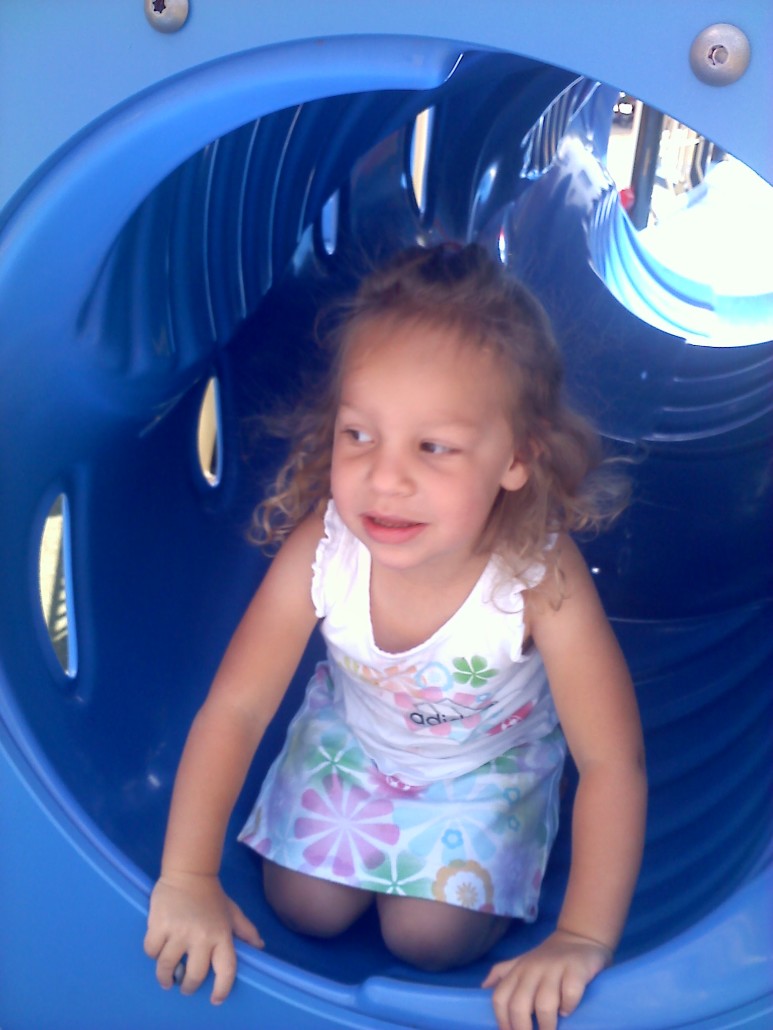
Slides: Last but not least, slides are also a great tool to help develop body strength and coordination. When a child slides down a slide, they have to keep their body upright in a sitting position. While they are doing this, inertia is pushing their trunk backward and they have to use their core to stay upright! When they land at the bottom, they again have to coordinate the front and back core muscles to keep from falling forward as the force of inertia is decreased on their trunk (when the movement stops). They also must stop themselves with their legs without losing their balance, which requires a lot of strength, control, and coordination of the legs and body!
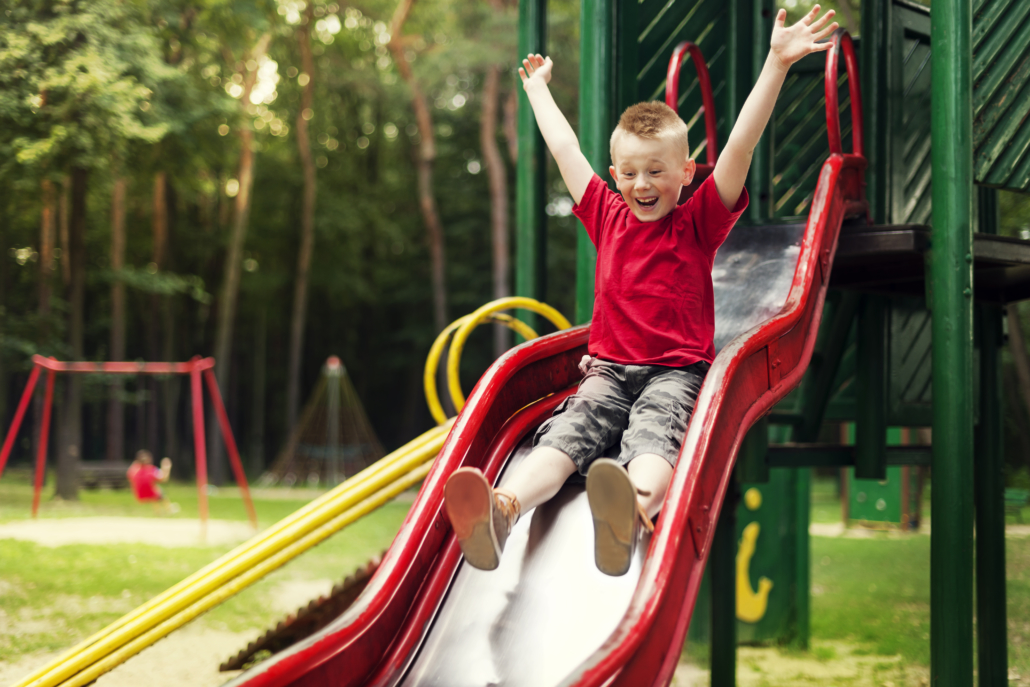
We hope you have so much fun on the playground this June! Remember to always supervise your kiddos while they are playing and stand close to them while they are trying new and difficult skills, in case they need your help! At the same time, remember that the playground is the perfect place for kids to take risks, challenge their skills and learn how to problem solve.
If your kiddo is having trouble with coordinating or performing some of these gross motor skills, give us a call at KidPT to schedule a free Discovery Visit today! We would love to talk to you about your child’s potential PT needs!
